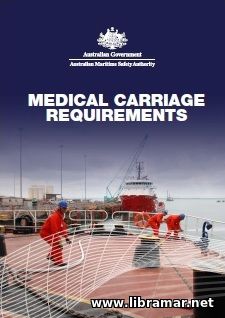 The official guidelines issued by the AMSA, standing for the Australian Maritime Safety Authority. Though the provisions of the present paper shall apply to the Australian vessels, the information contained in the document will be useful as a reference to any other ship. The standards related to the medical care of the seafarers are established by the MLC.
The publication starts with the general information followed by the medical carriage requirements including medicines and medical equipment. There is a separate chapter in this volume devoted to the ships engaged in transportation of the dangerous cargoes. The next chapter is dealing with the administration and storage of the medicals on board including their packaging and labeling, design and location of the shipboard medicine chest, inventory and medical log plus e-records.
You will also find all requirements applicable to the certification and inspection of the medicine chests and know the basic foreign drug regulations. The training and responsibilities have also been paid attention. Two annexes to the main content provide list of medicines and medical equipment. A must have publication on board any Australian ship and a recommended reference for all others.
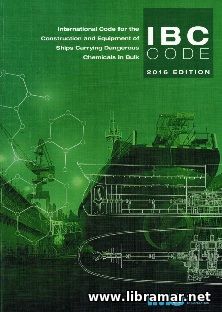 This is the official 2016 edition of the IMO IBC Code. The main declared purpose of the document is to provide the maritime shipping industry with the internationally recognized standard covering the safe transportation of the noxious liquid substances, i.e. NLS, and dangerous chemical substances in bulk form.
The provisions of the Code prescribe the standards that apply to the design and subsequent construction of the vessels carrying subject substances as well as the equipment that shall be carried on board in order to minimize any risk to the vessel, the crew members and marine environment. The content of the IBC Code is arranged in twenty-one chapters. The first one is introductory and pretty standard for most of the IMO-released publications.
It is followed by the chapters covering the survival capability of the vessel and cargo tanks location, arrangement of the ship including segregation of cargo, pump rooms, pumping and piping arrangements, ballast and bilge systems etc., cargo containment and transfer, construction materials, temperature control, venting and gas-freeing of the cargo tanks, electrical systems, fire protection/extinction arrangements, pollution prevention, human protection, instrumentation, applicable operational requirements, handling chemical wastes and other important areas.
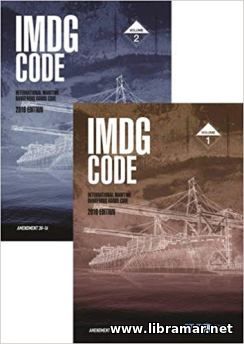 The present collection of files contains the IMDG Code 2016. It consists of two volumes of the Code itself supplemented with some additional information to be taken into consideration when applying the provisions of the IMDG Code. The main content of the IMDG Code has undergone significant changes over the past several years and its format has also been subjected to rearrangement.
This all was done in order to keep the Code in line with the rapidly expanding and developing maritime shipping industry. The Amdt. 38-16 contains the revisions made to the various parts of the IMDG Code including the requirements for transportation of the specific substances. The material of the Code is presented in two separate volumes and is arranged in seven parts.
The main body of the Code covers the general provisions, main definitions used in the document, security provisions and information on training of the personnel, classification of the dangerous goods carried on board ships, such as explosive, radioactive materials and others, packing and tank provisions, transport operations, consignment procedures etc.
There is a glossary of terminology provided in one of the appendices. Needless to say that the IMDG Code is a must-have publication on board every single ship engaged in the marine transportation of any dangerous goods.
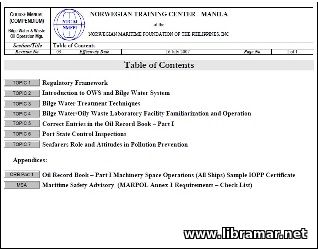 The content of the present training course has been designed specifically for the deck officers and engine room crew who are directly engaged in the operation and management of the bilge water treatment systems installed on board seagoing vessels. The idea of the program was to provide trainees with the necessary working knowledge of the current regulations and bilge water treatment techniques.
There are numerous practical exercises included in the body of the course to let trainees get better understanding of the bilge water operation and management with the main emphasis made on the bilge water treatment and its subsequent disposal. The program covers all relevant regulatory framework on oily water separators, treatment of the oily wastes generated on board ships, on-line monitoring systems and making entries to the ORB Part 1.
The trainees will get information about the port state control checks and site assessments, as well as of the role and attitude of the seafarers in connection with the environment protection and prevention of pollution. It will also be useful to the persons willing to upgrade their skills and knowledge and perform their duties in a better, safer and more efficient manner.
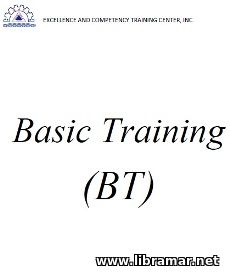 This is a nice and useful training tool developed and presented by the specialists of the Excellence & Competency Training Center. As it is stated in the title of the manual, its content is fully compliant with the latest amendments to the STCW Convention. The material of the book is arranged in four major parts.
The first part covers the emergency first aid giving all required information about the human body structure, basic principles of the emergency action, wounds and shocks, burns and bandaging, rescue and transfer of the people and basic life support.
The second part concentrates on the personal survival techniques including main principles of survival and evacuation, lifesaving appliances and arrangements on board ships, emergency situations, signaling equipment, personal lifesaving appliances such as lifejackets, lifebuoys and immersion suits etc.
The next part deals with the fire fighting and takes reader from the basic fire theory and fire tetrahedron, classification of fires, spread of fire and safe practices, fire prevention, detection and extinction. The last part addresses personal safety and social responsibilities including safe working practice, human relationships and communication onboard ships. transmission skills, SARS etc.
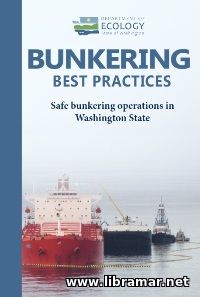 The present manual will give readers very useful and practical tips helping them to prevent dangerous oil spills. The authors of the guidebook encourage the crew members of all vessels operating in the area covered, i.e. Washington waters, to use the content for developing their bunkering policies and perform internal training. Establishing and using responsible and effective procedures for the transfer of oil will eventually reduces the number of the oil spill incidents and greatly contribute in the environment protection.
All of the practices that have been highlighted in the pages of this volume are meant to create a sort of the oil spill prevention mindset during the bunkering activities. Note that they are not intended to substitute the procedures on board the vessel or replace any of the federal requirements of the USCG. We all know that the fatigue and lack of attention couples with the poor communication and unclear procedures and policies are considered root causes of the oil spills.
The readers will start with the information on the oil spill reporting and then proceed to the bunker procedure checklist, duties of the watchstanders and personnel, training required to be performed for the bunker crew, operations during and after bunkering etc. This compact publication will shed some light on the important aspects of bunkering in the Washington waters; however the content will be equally useful to the crew members of the ships operating elsewhere.
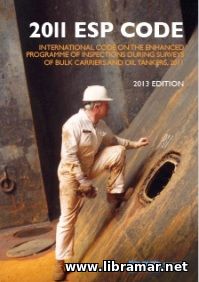 The present 2011 ESP Code was originally adopted in 2011 by Res. A.1049(2). It was later made mandatory through the amendments to Reg. XI-1/2 of SOLAS convention. Subject regulation requires oil tankers and bulk carriers to be subject to the enhanced inspection programme as per 2011 ESP Code.
The main purpose of the CAS, standing for the Condition Assessment Scheme, coming under the Annex I to the MARPOL convention is to verify that the structural condition of single hull oil tankers is acceptable at delivery of the vessel and continues to be acceptable - this is verified through periodical surveys.
The content of this Code consists of two annexes. The first Annex A covers the single-skin and double skin bulk carriers, while the Annex B is dealing with the double-hull oil tankers and other oil tankers. The Code is closely aligned with the content of IACS UR Z10 addressing hull surveys to make sure that it is kept user friendly and simple.
The publication is definitely a must have on board any bulk carrier and oil tanker and will also be interesting for the people working in a maritime industry and willing to be knowledgeable about all requirements that may be applied to the subject vessels.
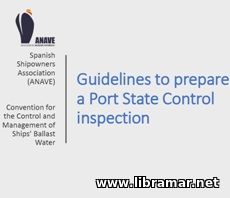 The publication released by the Spanish Shipowners Association will provide required guidance to the PSC inspection in connection with the provisions of the BWM Convention. This is just a compact booklet but it still provides concentrated information about the most important aspects to consider. The opening page of the paper will explain to which of the vessels the Convention is not applicable - obviously, these are vessels without the ballast tanks or having those tanks sealed. The companies having such ships in their fleet shall provide the captains with the instructions so that they ensure that, when asked for the PSC inspection certificate, they will claim that their vessel is not designed to carry the ballast water and is therefore not bound; they shall also preset the stability booklet proving this statement. Then the content of the booklet covers the national cabotage and what shall be taken into consideration in cabotage trades, certification paperwork and additional documents, preparing to the PSC initial inspection etc. In addition, the booklet contains useful check list to e used for ensuring due compliance with D-1 standard and list of detainable deficiencies.
« 1 2 ... 7 8 9 10 11 ... 24 25 » |







